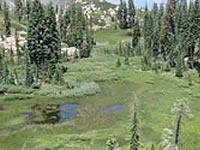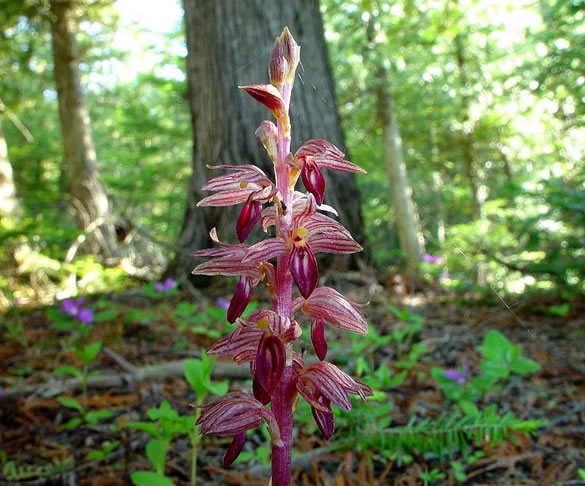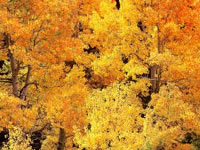Beauty of It All
Let's take a closer look at the beautiful wildflowers of our national forests and grasslands and their remarkable adaptations to the environment. Wildflowers have adapted to diverse environments and specialized habitats, including rainforest, bogs, deserts, grasslands, vernal pools, serpentines, high-elevations, and many others. They have developed remarkable strategies and unique adaptations to survive in harsh environments.
The story of wildflowers is one of complexity, mystery, and splendor. You will find yourself astounded and delighted by the “Beauty of It All!”
"I believe a leaf of grass is no less than the journey work of the stars…"
From "Leaves of Grass", Walt Whitman
California Fens
Fens are an important wetland type in the mountains of California. Fens are permanently saturated wetlands, receiving significant water and nutrients from a ground source of water. Ground water fed fens are widespread in the California mountains of the Sierra Nevada, coast range, and southern Cascades.
Aquilegia Express: Columbines
One of the most exquisite and most beloved wildflowers is the columbine. The magnificent rock-loving columbine brightens our hearts in cool, hidden forest grottos, and lifts our spirit high to alpine meadows and glacial mountain lakes. All aboard, as we learn about columbines and view their beautiful colors along the way!
Coralroot Orchids
In our second installment exploring the world of mycotrophic wildflowers, we examine the subtle beauty of the coralroot orchids in the genus Corallorhiza. As with most mycotrophic wildflowers, most coralroot orchids do not photosynthesize. Coralroot orchids obtain nutrients, minerals, and water by parasitizing a mycorrhizal fungus that absorbs nutrients from a photosynthetic plant, which gets water and minerals from the mycorrhizal fungus in return.
Fading Gold: The Decline of Aspen in the West
Fading Gold explores the aspen community in the western United States. It describes how aspen grows, the decline of aspen from in the Rocky Mountains to the Sierra Nevada Mountains, and the challenges for aspen in the western landscape. We feature aspen's beautiful fall colors, wildflowers in the aspen community, and the traces left in the aspen groves by past visitors.
Wildflowers, Part of the Pageantry of Fall Colors
For many wildflowers, fall is the time of the year when they flower, adding to the great array of colors. The U.S. Forest Service has many stories to share with you about our fall wildflowers.
Read about Wildflowers, Part of the Pageantry of Fall Colors…
Ferns
Usually people focus on the showy wildflowers and do not pay attention to the ferns. We will guide you through the wonderful diversity of ferns growing on America’s national forests and grasslands. Ferns are an outstanding part of the native flora.
Lichens
Let's take a look at the group of organisms called lichens. They are not plants in the classification of life forms, but rather they belong to the Fungi kingdom. Forest Service botanists and plant ecologists are the primary resource specialists who deal with the conservation and management of these beautiful and fascinating organisms.
Mycotrophic Wildflowers
Sometimes referred to as “fungus flowers,” mycotrophic wildflowers have no chlorophyll and spend most of their lives underground, but they are not fungi. Since they cannot make their own “food,” mycotrophic wildflowers parasitize mycorhizal fungus, which absorbs its nutrients from trees. The unlucky fungus “feeds” the parasitic wildflower and receives nothing in return.
These “thieves” come in a variety of colors—reds, yellows, white, pinks, and browns—most often found under thick layers of leaf litter in deep-shaded forests.
Our Native Irises
Irises greet us in springtime with spectacular, large, beautiful, eye-catching flowers. Like a rainbow, they exhibit a variety of colorful patterns and shades of blue to violet, pale delicate white or yellow, earthy tans and browns, to a flaunting copper-red, a stately deep maroon, and a brilliant yellow.
Klamath-Siskiyou Serpentines
Formed deep within the earth's mantle, serpentine rocks found their way to the surface over millennia. Unique flora have evolved on serpentine soils, especially adapted to survive severe hardships of drought, heavy metals, and nutrient stress. The Klamath-Siskiyou Mountains of northwest California and southwest Oregon are the largest serpentine area in North America.
Sky Islands
“Sky Islands” are isolated mountain ranges in southeastern Arizona and northern Mexico. Some of the mountains rise more than 6,000 feet above the surrounding desert floor making the lowlands and high peaks drastically different. Plants and animals living in the mountains could never survive in the surrounding deserts. Thus by analogy, the mountains are “islands” surrounded by deserts that are “seas”.
The Lady's Slipper Orchids
Did you know that in addition to the tall trees for which we are best known, a beautiful and sometimes hidden treasure of wondrous native orchids are on our National Forests and Grasslands?
Terrific Trilliums
Forty-three species of trillium are known worldwide with a startling thirty-eight represented in North America. Within the United States, the bulk of Trillium diversity is found in the eastern states where Terrific Trilliums are among the favorites on many a spring wildflower walk.
Tall Forb Community of the Intermountain West
Few landscapes can match the beauty and profusion of wildflowers found in the lush, subalpine mountain parklands of the interior western States. Among the most unexpected and rarest of the high elevation plant communities is one dominated solely by large, luxuriant wildflowers, commonly referred to as the Tall Forb Community type.















